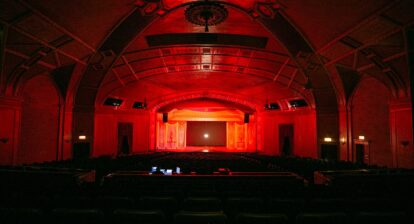New public health restrictions ordered by provincial governments in response to spiking COVID-19 cases impacted many industries in October. Those that were already among the hardest hit reported further job losses.
The performing arts, spectator sports and related industries sub-sector lost 4,800 more jobs in October (-2.7%). This is the third consecutive monthly decrease. Employment in the sub-sector is now 2.3% below the April record low and 31.8% lower than a year ago.
In order to provide a detailed picture of job losses in the arts, culture and heritage sub-sectors during the COVID-19 crisis, CAPACOA licenced access to custom employment statistics from Statistics Canada. These statistics are from the Labour Force Survey, a monthly survey of approximately 56,000 households. They provide an account of employment for full-time, part-time and occasional employees, as well as self-employed workers.
Key indicators for October 2020
- Employment in information and cultural industries [51] increased 4.0% in October. The increase is driven exclusively by motion picture and sound recording [512] (+9.7%) and telecommunications [517] (+7.3%). The information and cultural industries sector has now fully recovered all jobs lost since the beginning of the pandemic and is currently 17.8% above last year’s level. After a sharp increase in September, total actual hours worked in information and cultural industries went down 3.6% in October.
- Employment in the arts, entertainment and recreation sector [71] fell 10.1% in October. This follows a 10.6% drop in September. The largest decrease was observed in amusement, gambling and recreation industries [713] (-20.1%). Employment in the arts, entertainment and recreation sector [71] is now 23.3% lower than last year at the same period, and it remains the furthest away from recovery (relative to its size). Total actual hours worked in the arts, entertainment and recreation sector fell by roughly the same proportion as employment: they went down 11.1%. They were 28.4% lower than a year ago for the same period.
Focus on live performance industries
- The hemorrhage in live performance industries continued. Performing arts, spectator sports and related industries [711] lost 4,800 more jobs in October (-2.7%). This is the third consecutive monthly decrease. Employment in the sub-sector is now 2.3% below the April record low and 31.8% lower than a year ago.
- Total actual hours worked in performing arts, spectator sports and related industries [711] remained stable in October (-0.4%). On average, employed persons worked 22.9 hours per week. Average hours worked have been slowly increasing since April. They are now 13.3% below their pre-COVID level.
- The total labour force count continues to suggest a migration of the workforce to other industries. Labour force includes employed persons as well as unemployed persons who had looked for work in the past four weeks, and were available for work. Total performing arts, spectator sports and related industries [711] labour force participation decreased 3.5% in October. It was 22.0% lower than a year ago at the same period.
- Performing arts companies [7111] are the hardest hit among the hardest hit industries. Data for this industry group is now getting so sparse that it isn’t quite as reliable as it usually is, so the following figures must be interpreted with caution. Employment in performing arts companies fell by more than 40% in October. Most lost jobs were part-time jobs. If these figures are accurate, then almost 3 in 4 performing arts workers had lost their job in October compared to last year at the same period. That’s 29,000 performing arts workers who have lost their job. Of these close to 25,000 were no longer participating in the labour force for this industry in October. This means the vast majority of those who lost their job in the performing arts were either not actively looking for work in this industry or had found work in another industry. Performing arts companies are particularly at risk of facing a shortage of skilled workers when live performance activities resume.
Table 1 – Labour force estimates (x 1,000) by selected industry, Canada, unadjusted for seasonality
| Industry (with NAICS classification) | Labour force, Oct. 2020 (x 1,000) | c. previous month (x1,000) | c. previous month (%) | Oct. 2020 c. Oct. 2019 (x 1,000) | Oct. 2020 c. Oct. 2019 (%) |
|---|---|---|---|---|---|
| Total, all industries | 20287.8 | 23.2 | 0.1% | 29.7 | 0.1% |
| 51, 71 Information, culture and recreation 1 | 799 | -13.2 | -1.6% | 22.9 | 3.0% |
| 51 Information and cultural industries | 399.8 | 17.8 | 4.7% | 69.6 | 21.1% |
| 511 Publishing industries (except internet) | 69 | -2.6 | -3.6% | 9.2 | 15.4% |
| 512 Motion picture and sound recording industries | 93.3 | 6.7 | 7.7% | 6.2 | 7.1% |
| 515 Broadcasting (except internet) | 37.2 | -3.7 | -9.0% | 1.1 | 3.0% |
| 517 Telecommunications | 157.8 | 11.6 | 7.9% | 52.1 | 49.3% |
| 518 Data processing, hosting, and related services 3 | x | x | x | x | x |
| 519 Other information services | 36.3 | 6.2 | 20.6% | 7.2 | 24.7% |
| 71 Arts, entertainment and recreation | 399.2 | -31 | -7.2% | -46.7 | -10.5% |
| 711 Performing arts, spectator sports and related industries | 120.7 | -4.4 | -3.5% | -34.1 | -22.0% |
| 7111 Performing arts companies 2 | 15.6 | -11.8 | -43.1% | -24.8 | -61.4% |
| 7112 Spectator sports 2 | 9.1 | 3.2 | 54.2% | -10.2 | -52.8% |
| 7113 Promoters (presenters) of performing arts, sports and similar events 2 | 11.1 | -1.3 | -10.5% | 2.1 | 23.3% |
| 7114 Agents and managers for artists, athletes, entertainers and other public figures 3 | x | x | x | x | x |
| 7115 Independent artists, writers and performers | 82.3 | 4.8 | 6.2% | 0.1 | 0.1% |
| 712 Heritage institutions | 31.5 | -4.1 | -11.5% | -2.9 | -8.4% |
| 713 Amusement, gambling and recreation industries | 247.1 | -22.3 | -8.3% | -9.6 | -3.7% |
Table 2 – Employment estimates (x 1,000), by selected industries, Canada, unadjusted for seasonality
Industry (with NAICS classification) | Employment, Oct. 2020 (x 1,000) | c. previous month (x1,000) | c. previous month (%) | Oct. 2020 c. Oct. 2019 (x 1,000) | Oct. 2020 c. Oct. 2019 (%) |
|---|---|---|---|---|---|
| Total, all industries | 18636.9 | 72.4 | 0.4% | -601.9 | -3.1% |
| 51, 71 Information, culture and recreation 1 | 705.4 | -22.1 | -3.0% | -41.1 | -5.5% |
| 51 Information and cultural industries | 380.2 | 14.5 | 4.0% | 57.8 | 17.9% |
| 511 Publishing industries (except internet) | 66.7 | -2.6 | -3.8% | 7.6 | 12.9% |
| 512 Motion picture and sound recording industries | 86.3 | 7.6 | 9.7% | 4.6 | 5.6% |
| 515 Broadcasting (except internet) | 37.2 | -3.7 | -9.0% | 1.1 | 3.0% |
| 517 Telecommunications | 152.6 | 10.4 | 7.3% | 47.3 | 44.9% |
| 518 Data processing, hosting, and related services 3 | x | x | x | x | x |
| 519 Other information services 2 | 31.9 | 3.4 | 11.9% | 3 | 10.4% |
| 71 Arts, entertainment and recreation | 325.2 | -36.6 | -10.1% | -98.9 | -23.3% |
| 711 Performing arts, spectator sports and related industries | 104.1 | -4.8 | -4.4% | -48.5 | -31.8% |
| 7111 Performing arts companies 2 | 10.5 | -8.5 | -44.7% | -29 | -73.4% |
| 7112 Spectator sports 3 | x | x | x | x | x |
| 7113 Promoters (presenters) of performing arts, sports and similar events 3 | x | x | x | x | x |
| 7114 Agents and managers for artists, athletes, entertainers and other public figures 3 | x | x | x | x | x |
| 7115 Independent artists, writers and performers | 77.1 | 1.9 | 2.5% | -4.4 | -5.4% |
| 712 Heritage institutions | 29.7 | -2.6 | -8.0% | -2.4 | -7.5% |
| 713 Amusement, gambling and recreation industries | 191.3 | -29.2 | -13.2% | -48.1 | -20.1% |
Table 3 – Total actual hours worked estimates (x 1,000), by selected industries, Canada, unadjusted for seasonality
| Industry (with NAICS classification) | Total actual hours (x 1,000), Oct. 2020 | c. previous month (%) | Oct. 2020 c. Oct. 2019 (%) |
|---|---|---|---|
| Total, all industries | 570161.3 | -6.1% | -2.2% |
| 51, 71 Information, culture and recreation 1 | 20222 | -6.8% | -2.5% |
| 51 Information and cultural industries | 12624.4 | -3.6% | 24.6% |
| 511 Publishing industries (except internet) | 2085.7 | -16.2% | 14.4% |
| 512 Motion picture and sound recording industries | 2912.6 | 4.4% | 6.6% |
| 515 Broadcasting (except internet) 2 | 1259.7 | -13.3% | 19.3% |
| 517 Telecommunications | 5261.2 | -0.7% | 57.9% |
| 518 Data processing, hosting, and related services 2 | 221.3 | -16.6% | -52.1% |
| 519 Other information services 2 | 883.8 | 11.1% | 21.3% |
| 71 Arts, entertainment and recreation | 7597.6 | -11.6% | -28.4% |
| 711 Performing arts, spectator sports and related industries | 2383.6 | -0.4% | -40.8% |
| 7111 Performing arts companies 3 | x | x | x |
| 7112 Spectator sports 3 | x | x | x |
| 7113 Promoters (presenters) of performing arts, sports and similar events 3 | x | x | x |
| 7114 Agents and managers for artists, athletes, entertainers and other public figures 3 | x | x | x |
| 7115 Independent artists, writers and performers | 1651.7 | -1.0% | -18.6% |
| 712 Heritage institutions | 891.5 | -9.8% | -9.4% |
| 713 Amusement, gambling and recreation industries | 4322.5 | -17.1% | -22.8% |
Notes
- This series aggregates two distinct sectors. Statistics Canada aggregates culture industries in such a way in order to ensure data quality at small geographic levels. This aggregated series is included in order to enable some degree of comparisons with data tables published by Statistics Canada. The aggregation was performed by CAPACOA and no coefficient of variation for this series was provided by Statistics Canada. However, the aggregated data is presumed to be reliable because the coefficient of variation for each sector is very low.
- The sample for this series is small. Month-to-month variations in this series should be interpreted with caution.
- The sample for this series is very small. Data is unreliable and unsuited for release.
Additional notes about the Labour Force Survey
- “Labour force” estimates are the number of persons 15 years of age and over who, during the reference week, were employed or unemployed. “Unemployed” means persons who were without work, had looked for work in the past four weeks, and were available for work. Unemployed persons retain the NAICS industry classification of their previous job.
- “Employment” includes full-time, part-time and occasional employees, as well as self-employed workers who worked during the reference week, no matter how many hours. Certain sub-sectors that include a large proportion of self-employed workers, for example, independent artists may therefore not show a significant drop because those freelance workers may still have been considered “working”.
- “Total actual hours worked” is a good indicator of the impacts of COVID-related restrictions on the labour force, because it offers an account of both the number of employed workers and the hours they worked. It is a particularly relevant indicator for sub-sectors that include a lot of freelance and occasional workers (and who may be deemed as “employed” even if they only worked a few hours during the reference period).
- These statistics are not adjusted for seasonality (whereas many Statistics Canada tables are). Many culture industries are subject to significant seasonal variations. In order to have a fair estimation of employment change compared to pre-COVID level, it is therefore preferable to establish comparisons with the same period in 2019 rather than with February 2020.
- The “711 Performing arts, spectator sports and related industries” sub-sector is a larger industry grouping than the “Live Performance” domain used in the Culture Satellite Account, but it is a fair proxy that can be tracked over time. The 711 sub-sector involves activities that aren’t part of the live performance domain such as 7112 Spectator sports, as well as parts of 7113, 7114 and 7115. Definitions for each industry group are available in the North American Industry Classification System 2017. More details on the mapping between NAICS 711 and the live performance domain can be found in the Classification Guide for the Canadian Framework for Culture Statistics 2011.
- Equivalent employment statistics for other sectors of the Canadian economy can be found in Table 14-10-0022-01 Labour force characteristics by industry, monthly, unadjusted for seasonality.
More information
More statistics from the Labour Force Survey in The Daily
Employment in arts and culture industries, September 2020
Prepared by: Frédéric Julien, Director of Research and Development.








